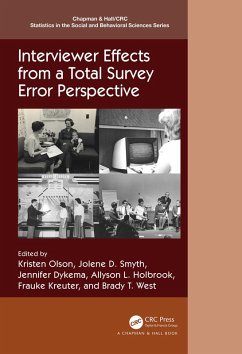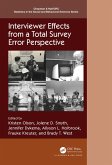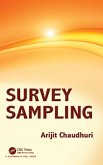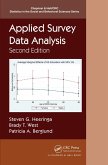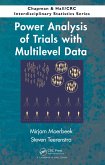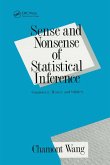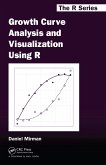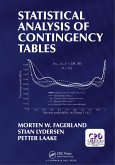Interviewer Effects from a Total Survey Error Perspective (eBook, ePUB)
Redaktion: Olson, Kristen; West, Brady T.; Kreuter, Frauke; Holbrook, Allyson L.; Dykema, Jennifer; Smyth, Jolene D.
56,95 €
56,95 €
inkl. MwSt.
Sofort per Download lieferbar

28 °P sammeln
56,95 €
Als Download kaufen

56,95 €
inkl. MwSt.
Sofort per Download lieferbar

28 °P sammeln
Jetzt verschenken
Alle Infos zum eBook verschenken
56,95 €
inkl. MwSt.
Sofort per Download lieferbar
Alle Infos zum eBook verschenken

28 °P sammeln
Interviewer Effects from a Total Survey Error Perspective (eBook, ePUB)
Redaktion: Olson, Kristen; West, Brady T.; Kreuter, Frauke; Holbrook, Allyson L.; Dykema, Jennifer; Smyth, Jolene D.
- Format: ePub
- Merkliste
- Auf die Merkliste
- Bewerten Bewerten
- Teilen
- Produkt teilen
- Produkterinnerung
- Produkterinnerung

Bitte loggen Sie sich zunächst in Ihr Kundenkonto ein oder registrieren Sie sich bei
bücher.de, um das eBook-Abo tolino select nutzen zu können.
Hier können Sie sich einloggen
Hier können Sie sich einloggen
Sie sind bereits eingeloggt. Klicken Sie auf 2. tolino select Abo, um fortzufahren.

Bitte loggen Sie sich zunächst in Ihr Kundenkonto ein oder registrieren Sie sich bei bücher.de, um das eBook-Abo tolino select nutzen zu können.
The book presents a collection of research on interviewer-administered survey data collection. Interviewers play an essential role in the collection of quality survey data used to learn about society and improve human condition. Attention to the methodology that underlies survey interviewing is essential for data collections to succeed.
- Geräte: eReader
- ohne Kopierschutz
- eBook Hilfe
- Größe: 4.49MB
Andere Kunden interessierten sich auch für
![Interviewer Effects from a Total Survey Error Perspective (eBook, PDF) Interviewer Effects from a Total Survey Error Perspective (eBook, PDF)]() Interviewer Effects from a Total Survey Error Perspective (eBook, PDF)56,95 €
Interviewer Effects from a Total Survey Error Perspective (eBook, PDF)56,95 €![Survey Sampling (eBook, ePUB) Survey Sampling (eBook, ePUB)]() Arijit ChaudhuriSurvey Sampling (eBook, ePUB)52,95 €
Arijit ChaudhuriSurvey Sampling (eBook, ePUB)52,95 €![Applied Survey Data Analysis (eBook, ePUB) Applied Survey Data Analysis (eBook, ePUB)]() Steven G. HeeringaApplied Survey Data Analysis (eBook, ePUB)48,95 €
Steven G. HeeringaApplied Survey Data Analysis (eBook, ePUB)48,95 €![Power Analysis of Trials with Multilevel Data (eBook, ePUB) Power Analysis of Trials with Multilevel Data (eBook, ePUB)]() Mirjam MoerbeekPower Analysis of Trials with Multilevel Data (eBook, ePUB)48,95 €
Mirjam MoerbeekPower Analysis of Trials with Multilevel Data (eBook, ePUB)48,95 €![Sense and Nonsense of Statistical Inference (eBook, ePUB) Sense and Nonsense of Statistical Inference (eBook, ePUB)]() Charmont WangSense and Nonsense of Statistical Inference (eBook, ePUB)64,95 €
Charmont WangSense and Nonsense of Statistical Inference (eBook, ePUB)64,95 €![Growth Curve Analysis and Visualization Using R (eBook, ePUB) Growth Curve Analysis and Visualization Using R (eBook, ePUB)]() Daniel MirmanGrowth Curve Analysis and Visualization Using R (eBook, ePUB)54,95 €
Daniel MirmanGrowth Curve Analysis and Visualization Using R (eBook, ePUB)54,95 €![Statistical Analysis of Contingency Tables (eBook, ePUB) Statistical Analysis of Contingency Tables (eBook, ePUB)]() Morten FagerlandStatistical Analysis of Contingency Tables (eBook, ePUB)57,95 €
Morten FagerlandStatistical Analysis of Contingency Tables (eBook, ePUB)57,95 €-
-
-
The book presents a collection of research on interviewer-administered survey data collection. Interviewers play an essential role in the collection of quality survey data used to learn about society and improve human condition. Attention to the methodology that underlies survey interviewing is essential for data collections to succeed.
Dieser Download kann aus rechtlichen Gründen nur mit Rechnungsadresse in A, B, BG, CY, CZ, D, DK, EW, E, FIN, F, GR, HR, H, IRL, I, LT, L, LR, M, NL, PL, P, R, S, SLO, SK ausgeliefert werden.
Produktdetails
- Produktdetails
- Verlag: Taylor & Francis eBooks
- Seitenzahl: 360
- Erscheinungstermin: 10. Mai 2020
- Englisch
- ISBN-13: 9781000064476
- Artikelnr.: 59428806
- Verlag: Taylor & Francis eBooks
- Seitenzahl: 360
- Erscheinungstermin: 10. Mai 2020
- Englisch
- ISBN-13: 9781000064476
- Artikelnr.: 59428806
- Herstellerkennzeichnung Die Herstellerinformationen sind derzeit nicht verfügbar.
Kristen Olson, Ph.D., is Leland J. and Dorothy H. Olson Professor and Vice Chair of the Department of Sociology at the University of Nebraska-Lincoln. Jennifer Dykema, Ph.D., is Distinguished Scientist and Senior Survey Methodologist at the University of Wisconsin Survey Center. Allyson L. Holbrook, Ph.D., is a Professor of Public Administration and Psychology at the University of Illinois at Chicago. Frauke Kreuter, Ph.D., is Director of the Joint Program in Survey Methodology at the University of Maryland, Professor of Statistics and Methodology at the University of Mannheim, and Head of the Statistical Methods Research Department (on leave) at the Institute for Employment Research in Nuremberg. Jolene D. Smyth, Ph.D., is an Associate Professor in the Department of Sociology and the Director of the Bureau of Sociological Research at the University of Nebraska-Lincoln. Brady T. West, Ph.D., is a Research Associate Professor in the Survey Research Center at the Institute for Social Research on the University of Michigan-Ann Arbor campus.
Section I. History and Overview
Chapter 1: The Past, Present, and Future of Research on Interviewer Effects
Chapter 2: The Legacy of Charles Cannell
Section II: Training Interviewers
Chapter 3: General Interviewing Techniques: Developing Evidence-Based
Practices for Standardized Interviewing
Chapter 4: How to Conduct Effective Interviewer Training: A Meta-Analysis
and Systematic Review
Section III: Managing and Monitoring Interviewers and the Survey Process
Chapter 5: Exploring the Mind of the Interviewer: Findings from Research
with Interviewers to Improve the Survey Process
Chapter 6: Behavior Change Techniques for Reducing Interviewer
Contributions to Total Survey Error
Chapter 7: Statistical Identification of Fraudulent Interviews in Surveys:
Improving Interviewer Controls
Chapter 8: Examining the Utility of Interviewer Observations on the Survey
Response Process
Section IV: Interviewer Effects and Interview Context and Mode
Chapter 9: Why do Interviewers Vary in Achieving Interview Privacy and Does
Privacy Matter?
Chapter 10: Unintended Interviewer Bias in a Community-based Participatory
Research Randomized Control Trial among American Indian Youth
Chapter 11: Virtual Interviewers, Social Identities, and Survey Measurement
Error
Chapter 12: Differences in Interaction Quantity and Conversational Flow in
CAPI and CATI Interviews
Chapter 13: Interacting with Interviewers in Voice and Text Interviews on
Smartphones
Section V: Interviewers and Nonresponse
Chapter 14: Explaining Interviewer Effects on Survey Unit Nonresponse: A
Cross-Survey Analysis
Chapter 15: Comparing Two Methods for Managing Telephone Interview Cases
Chapter 16: Investigating the Use of Nurse Paradata in Understanding
Nonresponse to Biological Data Collection
Section VI: Interview Pace and Behaviors
Chapter 17: Exploring the Antecedents and Consequences of Interviewer
Reading Speed (IRS) at the Question Level
Chapter 18: Response Times as an Indicator of Data Quality: Associations
with Question, Interviewer, and Respondent Characteristics in a Health
Survey of Diverse Respondents
Chapter 19: Accuracy and Utility of Using Paradata to Detect
Question-Reading Deviations
Chapter 20: What do Interviewers Learn? Changes in Interview Length and
Interviewer Behaviors over the Field Period
Section VII: Estimating Interviewer Effects
Chapter 21: Modeling Interviewer Effects in the National Health Interview
Study
Chapter 22: A Comparison of Different Approaches to Examining Whether
Interviewer Effects Tend to Vary Across Different Subgroups of Respondents
Chapter 23: Designing Studies for Comparing Interviewer Variance in Two
Groups of Survey Interviewers
Chapter 1: The Past, Present, and Future of Research on Interviewer Effects
Chapter 2: The Legacy of Charles Cannell
Section II: Training Interviewers
Chapter 3: General Interviewing Techniques: Developing Evidence-Based
Practices for Standardized Interviewing
Chapter 4: How to Conduct Effective Interviewer Training: A Meta-Analysis
and Systematic Review
Section III: Managing and Monitoring Interviewers and the Survey Process
Chapter 5: Exploring the Mind of the Interviewer: Findings from Research
with Interviewers to Improve the Survey Process
Chapter 6: Behavior Change Techniques for Reducing Interviewer
Contributions to Total Survey Error
Chapter 7: Statistical Identification of Fraudulent Interviews in Surveys:
Improving Interviewer Controls
Chapter 8: Examining the Utility of Interviewer Observations on the Survey
Response Process
Section IV: Interviewer Effects and Interview Context and Mode
Chapter 9: Why do Interviewers Vary in Achieving Interview Privacy and Does
Privacy Matter?
Chapter 10: Unintended Interviewer Bias in a Community-based Participatory
Research Randomized Control Trial among American Indian Youth
Chapter 11: Virtual Interviewers, Social Identities, and Survey Measurement
Error
Chapter 12: Differences in Interaction Quantity and Conversational Flow in
CAPI and CATI Interviews
Chapter 13: Interacting with Interviewers in Voice and Text Interviews on
Smartphones
Section V: Interviewers and Nonresponse
Chapter 14: Explaining Interviewer Effects on Survey Unit Nonresponse: A
Cross-Survey Analysis
Chapter 15: Comparing Two Methods for Managing Telephone Interview Cases
Chapter 16: Investigating the Use of Nurse Paradata in Understanding
Nonresponse to Biological Data Collection
Section VI: Interview Pace and Behaviors
Chapter 17: Exploring the Antecedents and Consequences of Interviewer
Reading Speed (IRS) at the Question Level
Chapter 18: Response Times as an Indicator of Data Quality: Associations
with Question, Interviewer, and Respondent Characteristics in a Health
Survey of Diverse Respondents
Chapter 19: Accuracy and Utility of Using Paradata to Detect
Question-Reading Deviations
Chapter 20: What do Interviewers Learn? Changes in Interview Length and
Interviewer Behaviors over the Field Period
Section VII: Estimating Interviewer Effects
Chapter 21: Modeling Interviewer Effects in the National Health Interview
Study
Chapter 22: A Comparison of Different Approaches to Examining Whether
Interviewer Effects Tend to Vary Across Different Subgroups of Respondents
Chapter 23: Designing Studies for Comparing Interviewer Variance in Two
Groups of Survey Interviewers
Section I. History and Overview
Chapter 1: The Past, Present, and Future of Research on Interviewer Effects
Chapter 2: The Legacy of Charles Cannell
Section II: Training Interviewers
Chapter 3: General Interviewing Techniques: Developing Evidence-Based
Practices for Standardized Interviewing
Chapter 4: How to Conduct Effective Interviewer Training: A Meta-Analysis
and Systematic Review
Section III: Managing and Monitoring Interviewers and the Survey Process
Chapter 5: Exploring the Mind of the Interviewer: Findings from Research
with Interviewers to Improve the Survey Process
Chapter 6: Behavior Change Techniques for Reducing Interviewer
Contributions to Total Survey Error
Chapter 7: Statistical Identification of Fraudulent Interviews in Surveys:
Improving Interviewer Controls
Chapter 8: Examining the Utility of Interviewer Observations on the Survey
Response Process
Section IV: Interviewer Effects and Interview Context and Mode
Chapter 9: Why do Interviewers Vary in Achieving Interview Privacy and Does
Privacy Matter?
Chapter 10: Unintended Interviewer Bias in a Community-based Participatory
Research Randomized Control Trial among American Indian Youth
Chapter 11: Virtual Interviewers, Social Identities, and Survey Measurement
Error
Chapter 12: Differences in Interaction Quantity and Conversational Flow in
CAPI and CATI Interviews
Chapter 13: Interacting with Interviewers in Voice and Text Interviews on
Smartphones
Section V: Interviewers and Nonresponse
Chapter 14: Explaining Interviewer Effects on Survey Unit Nonresponse: A
Cross-Survey Analysis
Chapter 15: Comparing Two Methods for Managing Telephone Interview Cases
Chapter 16: Investigating the Use of Nurse Paradata in Understanding
Nonresponse to Biological Data Collection
Section VI: Interview Pace and Behaviors
Chapter 17: Exploring the Antecedents and Consequences of Interviewer
Reading Speed (IRS) at the Question Level
Chapter 18: Response Times as an Indicator of Data Quality: Associations
with Question, Interviewer, and Respondent Characteristics in a Health
Survey of Diverse Respondents
Chapter 19: Accuracy and Utility of Using Paradata to Detect
Question-Reading Deviations
Chapter 20: What do Interviewers Learn? Changes in Interview Length and
Interviewer Behaviors over the Field Period
Section VII: Estimating Interviewer Effects
Chapter 21: Modeling Interviewer Effects in the National Health Interview
Study
Chapter 22: A Comparison of Different Approaches to Examining Whether
Interviewer Effects Tend to Vary Across Different Subgroups of Respondents
Chapter 23: Designing Studies for Comparing Interviewer Variance in Two
Groups of Survey Interviewers
Chapter 1: The Past, Present, and Future of Research on Interviewer Effects
Chapter 2: The Legacy of Charles Cannell
Section II: Training Interviewers
Chapter 3: General Interviewing Techniques: Developing Evidence-Based
Practices for Standardized Interviewing
Chapter 4: How to Conduct Effective Interviewer Training: A Meta-Analysis
and Systematic Review
Section III: Managing and Monitoring Interviewers and the Survey Process
Chapter 5: Exploring the Mind of the Interviewer: Findings from Research
with Interviewers to Improve the Survey Process
Chapter 6: Behavior Change Techniques for Reducing Interviewer
Contributions to Total Survey Error
Chapter 7: Statistical Identification of Fraudulent Interviews in Surveys:
Improving Interviewer Controls
Chapter 8: Examining the Utility of Interviewer Observations on the Survey
Response Process
Section IV: Interviewer Effects and Interview Context and Mode
Chapter 9: Why do Interviewers Vary in Achieving Interview Privacy and Does
Privacy Matter?
Chapter 10: Unintended Interviewer Bias in a Community-based Participatory
Research Randomized Control Trial among American Indian Youth
Chapter 11: Virtual Interviewers, Social Identities, and Survey Measurement
Error
Chapter 12: Differences in Interaction Quantity and Conversational Flow in
CAPI and CATI Interviews
Chapter 13: Interacting with Interviewers in Voice and Text Interviews on
Smartphones
Section V: Interviewers and Nonresponse
Chapter 14: Explaining Interviewer Effects on Survey Unit Nonresponse: A
Cross-Survey Analysis
Chapter 15: Comparing Two Methods for Managing Telephone Interview Cases
Chapter 16: Investigating the Use of Nurse Paradata in Understanding
Nonresponse to Biological Data Collection
Section VI: Interview Pace and Behaviors
Chapter 17: Exploring the Antecedents and Consequences of Interviewer
Reading Speed (IRS) at the Question Level
Chapter 18: Response Times as an Indicator of Data Quality: Associations
with Question, Interviewer, and Respondent Characteristics in a Health
Survey of Diverse Respondents
Chapter 19: Accuracy and Utility of Using Paradata to Detect
Question-Reading Deviations
Chapter 20: What do Interviewers Learn? Changes in Interview Length and
Interviewer Behaviors over the Field Period
Section VII: Estimating Interviewer Effects
Chapter 21: Modeling Interviewer Effects in the National Health Interview
Study
Chapter 22: A Comparison of Different Approaches to Examining Whether
Interviewer Effects Tend to Vary Across Different Subgroups of Respondents
Chapter 23: Designing Studies for Comparing Interviewer Variance in Two
Groups of Survey Interviewers
